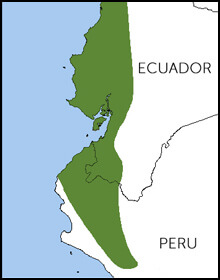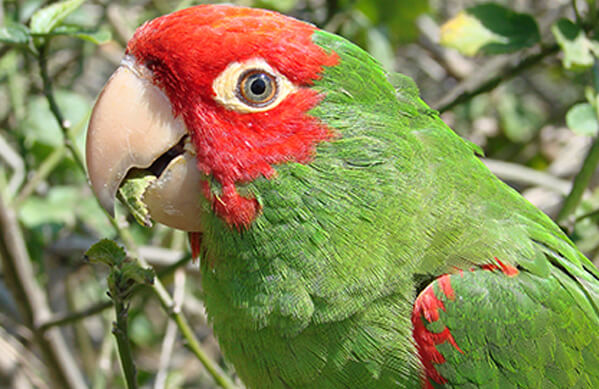 Like the Santa Marta and Golden-Plumed Parakeets, the Red-masked Parakeet is a sociable bird, with a wide repertoire of flock, social, alarm, and contact calls. During the day, this species can been found in pairs or small flocks of up to 12 birds. At night, the birds gather at communal roosts which can number up to 200, sometimes in mixed flocks with other parrots.
Like the Santa Marta and Golden-Plumed Parakeets, the Red-masked Parakeet is a sociable bird, with a wide repertoire of flock, social, alarm, and contact calls. During the day, this species can been found in pairs or small flocks of up to 12 birds. At night, the birds gather at communal roosts which can number up to 200, sometimes in mixed flocks with other parrots.
The Red-masked Parakeet was once common throughout its range in Ecuador and Peru. In recent decades, the species has declined due to habitat loss and fragmentation, along with trapping for the pet trade.
This parakeet is considered to be a good “talker” by pet bird aficionados and is a popular cage bird in its native countries and abroad, where it is also known as the Cherry-headed or Red-headed Conure.
Birds that have escaped from captivity sometimes form feral populations, with established flocks in Spain, Puerto Rico, and the United States, particularly in Hawai'i, Florida, and California. The feral Red-masked Parakeet population in San Francisco is one of the species highlighted in the popular documentary “The Wild Parrots of Telegraph Hill.”
Nesting in Numbers
Red-masked Parakeets feed on a wide variety of seeds, fruit, and flowers. As with many other species of fruit-eating avian species (like the Great Green Macaw), this parakeet is somewhat nomadic, making seasonal movements to take advantage of trees that provide fruit and seeds during the wet and dry seasons.
Sign up for ABC's eNews to learn how you can help protect birds

Red-masked Parakeet by Jonathan Chancasana, Shutterstock
The birds nest colonially, and pairs form long-term bonds. In the species' native range, nesting occurs during the rainy season (January through March), and a single clutch of two to four eggs is laid.
These parakeets are secondary cavity nesters, meaning that they do not excavate their own nest holes. They depend on other animals, particularly woodpeckers, to dig out potential nest areas.
Red-masked Parakeets most often nest in trees but have also been seen using cavities in termite nests and holes on cliff faces. Nestlings fledge with all-green plumage and gradually acquire their characteristic red plumage as they age.
Preserve a Home for Red-masked Parakeet
The Red-masked Parakeet can be seen at Ecuador's Buenaventura Reserve, established in 1999 by ABC partner Fundación Jocotoco. Now encompassing 5,583 acres as a result of acquisitions supported by ABC and others, the reserve boasts a lodge and trail system where visitors can look for this bird and other species, including the El Oro Parakeet and Long-wattled Umbrellabird. (More information on visiting Buenaventura can be found here.)
ABC recently partnered with World Land Trust to support Jocotoco in the purchase of a 233-acre addition that will expand the Buenaventura reserve. This land purchase ensures that birds such as the Red-masked Parakeet will have a safe home.
Donate to support ABC's conservation mission!



















































